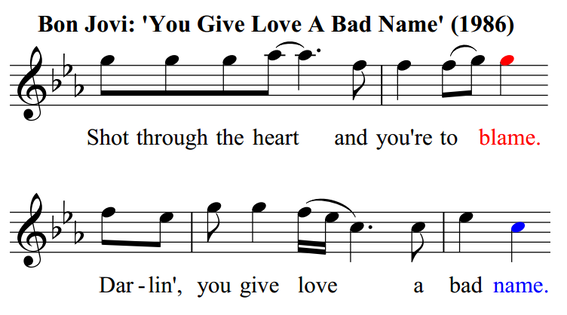|
Most pop music lyrics rhyme. And most of those rhymes are symmetric, meaning the rhymed syllables fall on the same rhythmic beat of different measures. Take, for example, the first verse (0:12-0:32) of Maren Morris' 2016 hit '80s Mercedes': In the first line she rhymes "last" with "dash", and in the second line she rhymes "practicality" with "me". All rhyming syllables are on the fourth beats of their measures (highlighted in red). This rhythmic consistency makes the rhymes symmetric. But some songs break this pattern. The choruses of Madonna's 'Material Girl', for example, rhyme "world" with "girl", but the former is heard just before beat 3 (red) while the latter is heard just before beat 1 (blue). This lack of rhythmic consistency makes the rhymes asymmetric. A more unusual example is Bon Jovi's 'You Give Love A Bad Name'. This time the syllable heard first on beat 3 ("blame" in red) is paired with the rhyming syllable on beat 2 ("name" in blue). The shift from beat 3 to beat 2 yields a displacement of one beat - unlike the 'Material Girl' example above, which pairs beats 3 and 1, a displacement of two beats, which is much more common. One of the things that makes 'Bad Name' a particularly interesting example is that the lead guitar, which obviously can't sing lyrics, retains this asymmetry in the introduction (0:13-0:20). This proves that music doesn't necessarily need rhymes to employ asymmetry. It's just most common and most noticeable though lyrics. For some reason - I have yet to pinpoint why - asymmetric rhymes seem to be most common in country styles. As a mandolin player, I'm quite fond of bluegrass, and Harley Allen and Mike Lilly's 'Suzanne' employs asymmetric rhymes in both the verses and choruses, each using the more conventional pairings of beats 3 (red) and 1 (blue). Another conventional 3-to-1 country example is found in The Nitty Gritty Dirt Band's 'Baby's Got A Hold On Me': Since asymmetric rhymes are more of a rhythmic device than a lyrical one, musicians could easily employ the same trick but on a deeper, hypermetric level. Indeed, hypermetric asymmetric rhymes can be heard in my opening example, '80s Mercedes'. The verses, as described above, use two-bar phrases with symmetric rhymes on the fourth beat of the first measures. But the prechorus speeds things up to a single measure.
The prechoruses rhyme "go" and "soul" just before beat 4 (in red). While these are still symmetric because each rhyme is on the same beat within the measure, the hypermetric quickening gives the impression of asymmetry in this specific context. However, in the last measure of the prechorus, she stutters, putting "go" just before beat 2 (in blue). And that is true asymmetric rhyming.
0 Comments
|
Aaron Krerowicz, pop music scholarAn informal but highly analytic study of popular music. Archives
August 2019
Categories
All
|








 RSS Feed
RSS Feed
